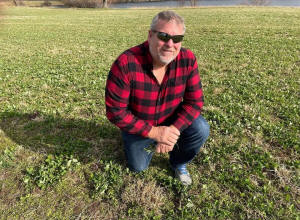Illinois’ soil conservation funding stagnates amid recent high-profile
dust storms
[June 26, 2025]
By Jade Aubrey and UIS Public Affairs Reporting (PAR)
SPRINGFIELD —– Three main factors contribute to the formation of Midwest
dust storms: strong winds, dry soil in farm fields and large amounts of
loose soil.
That’s according to Andy Taylor, the Science and Operations officer at
the National Weather Service’s office in Lincoln. He said these are key
ingredients that meteorologists, farmers and experts in the agricultural
community have found cause dust storms when they converge.
On May 16, Chicago saw its first major dust storm since the Dust Bowl,
which stretched from Texas to New York in the early 1930s and deposited
300 million tons of soil across the nation – 12 million tons of which
settled in the Chicago region, according to the Bill of Rights
Institute. The storm in May dropped visibility in the city to near zero
as wind gusts blew over 60 mph at times, according to the National
Weather Service.
Taylor said the atmospheric environment that day was more characteristic
of the dry environments in the High Plains or Southwest U.S., not the
Midwest. As rain began to fall near Bloomington, it quickly evaporated
and cooled the atmosphere, creating strong pockets of wind that began to
move North. And as winds sped up, the storm began to pick up and move
dry and loose soil from fields it passed over, which created the dust
storm.
“The type of dust storm event that we had that affected the Chicago
area, I wouldn’t necessarily take that occurrence as saying we’re going
to see an increase in those type of events from this point on,” he said.
“Although, anytime you see all those ingredients come together, we
certainly could see that again.”

Soil conservation funding ‘deprioritized’
While there were no deaths due to the storm in Chicago, a major dust
storm that occurred in central Illinois on a portion of I-55 resulted in
a multi-car pileup that took the lives of eight people and injured
dozens more in May 2023.
That dust storm also dropped visibility to zero on the stretch of the
interstate between Farmersville and Divernon, and was again caused by
dry, loose soil being picked up and moved by winds.
Although Taylor said dust storms are not new to Illinois – as his office
has documented events back to the 80s – most of the storms don’t move
across vast expanses of the state. Instead, he said they often occur in
more localized areas, like the storm near Divernon in 2023.
“When we’re seeing the right weather-related factors coming together and
the ground is fairly dry, which matches up with loose soil so we know
we’re going to be more prone to blowing dust, we coordinate with
partners in the agricultural community to determine when we might
anticipate those blowing dusts events,” Taylor said.
The Association of Illinois Soil and Water Conservation Districts has
been lobbying for increased funding for additional district employees.
This year’s state budget allows for each district to staff one full-time
employee, which AISWCD Executive Director Eliot Clay called “wildly
inadequate” as he said each district needs at least two.
“I really, honestly think conservation funding has been deprioritized,”
he said.
What do soil and water conservation districts do?
Soil and water conservation districts began to crop up across the U.S.
in the late 1930s as a response to the Dust Bowl and Congress’
subsequent declaration of soil and water conservation as a national
priority. According to the Association of Illinois Soil and Water
Conservation Districts, that declaration prompted then-President
Franklin D. Roosevelt to recommend legislation to state lawmakers that
would enact districts in every state.

Illinois has 97 districts, or nearly one district for every county in
the state. Employees of the districts are responsible for a variety of
tasks – including assessing farmland, educating farmers about
conservation practices and connecting farmers with grants from the state
and federal government. These all play a key role in the association’s
mission of protecting Illinois’ natural resources.
“Unlike a group like the Department of Natural Resources or the EPA or
even the Department of Agriculture, SWCDs are not a regulatory body,”
Clay said. “We are not going out there and enforcing rules and laws on
people, we’re just trying to help farmers do better. And that’s the
reason why a lot of farmers rely on SWCDs, is because they do not see us
as like, the ‘government’ coming in and telling them, ‘this is how
you’re going to do your operation.’”
Soil conservation funding stagnates
The fiscal year 2026 budget signed by Gov. JB Pritzker last week allots
$7.5 million to the state’s SWCDs – which Clay said is the same amount
the association received in the previous fiscal year. However, he said
that number was a $1 million cut from the FY24 budget allocation.
Of that $7.5 million, $3 million will go to cost-share grants, which act
as reimbursements to farmers for the costs of implementing both state
and federal conservation policies, such as cover crops. The remaining
$4.5 million will go to administrative costs.

[to top of second column]
|

State Rep. Charlie Meier, R-Okawville, shows clover growing in a
field on his Washington County farm in 2022. In 2009, Meier was
awarded the State of Illinois Conservation Farm Family of the Year.
(Capitol News Illinois file photo by Beth Hundsdorfer)

Clay said the breakdown of that $4.5 million provides $40,000 to each
Soil and Water Conservation district – meaning that every district will
have enough funds to pay one full-time employee. He called the salary
“wildly inadequate” for the district employees, most of whom have
college degrees.
“$40,000 – and that’s supposed to include benefits, so their take-home
is less than that – is barely enough, I mean I would say it’s not enough
even for one person” Clay said. “And it’s hard to keep people and
incentivize people to come to work when there’s not the kind of money
there that there should be.”
In addition, Clay said each district needs two full-time employees to be
fully-staffed – one to make on-site visits to farms and one to
coordinate schedules, receive phone calls and emails, and staff the
office.
He said in recent years, the association was told by both the Department
of Agriculture and the governor’s office that if they wanted more
funding, they would have to advocate for the money to individual
lawmakers outside of budget negotiations.
“I don’t know of any other agency or subsect of an agency that has to,
on their own, go to the Capitol and get money,” he said. “That’s very
peculiar to me and is something I’ve been trying to wrap my head around,
and I have not gotten a good explanation from anybody.”
The governor’s office did not respond to a request for comment.
Over the past two years, Clay said the association unsuccessfully
lobbied for $10.5 million in annual funding.
“The bigger question I’m left with after being the executive director
over the past six months and witnessing it from this angle is, what does
the legislature and the administration value?” Clay said. “It really
gets to bigger questions about how the state has dealt with conservation
funding in general for the last 20-plus years.”
Soil conservation efforts and farming practices
Kevin Brooks, a commercial agriculture educator at the University of
Illinois Urbana-Champaign, said the agriculture community has identified
practices farmers can use to reduce the amount of dry, loose topsoil in
their fields.

“Measuring the humidity level as a cause is not the issue,” Brooks said
in an interview with Capitol News Illinois. “I won’t say it’s not 100%
not about the weather, but this is primarily about tillage.”
One suggestion he made was for farmers to till their fields less
frequently and instead resort to strip-tilling or using no-till
strategies whenever possible to reduce the amount of loose topsoil in
fields.
Strip-till is a tilling practice where only narrow rows of a field where
seeds will be planted are tilled, leaving the rest of the field
untouched. While there are many short- and long-term benefits to
strip-tilling, no-till practices often don’t seem to benefit farmers
right away but do often have long-term advantages, Brooks said.
Rep. Charles Meier, R-Okawville, farms 1,500 acres in southern Illinois
with his family, including corn, wheat, beans, hay, and beef cattle. He
said most crops are already minimally tilled by farmers.
“I’m 66 years old and we never no-tilled when I was a kid,” he told
Capitol News Illinois. “All of our conventional soybeans are no-tilled
now, all of our wheat is done by minimal-till, and our corn is all by
minimal-till now.”
He said he’s in frequent contact with his SWCD, including a call on
Monday with his district’s employee, and criticized Democratic
leadership’s funding priorities, such as subsidies for renewable energy.
“They’re not funding the nuts and bolts of Illinois conservation,” Meier
said. “I’m not against wind and solar but they don’t pay for themselves
and they’re making us taxpayers pay for them.”
Another main practice Brooks recommended farmers employ was planting
cover crops, which are crops planted after harvest not for their
produce, but for their benefits to the soil. Cover crops can be planted
after a fall harvest for a variety of benefits, including to preserve
topsoil through the winter, increase organic matter in the soil and dry
the field earlier in the spring.

Brooks also attributed recent dust storms to the invention of high-speed
discs – a tillage attachment with many more disks than normal tillage
attachments, which tills at faster rates. He said these disks have taken
tillage speeds from around 4 mph to over 10, and that farmers in
Illinois quickly amassed these machines during and after the COVID-19
pandemic, due to the pandemic relief funds they received.
“In theory, they’re supposed to be a kind of conservation because they
don’t go into the ground very deep,” Brooks said. “But they literally
turn the top several inches of a farm field into powder.”
Capitol News Illinois is
a nonprofit, nonpartisan news service that distributes state government
coverage to hundreds of news outlets statewide. It is funded primarily
by the Illinois Press Foundation and the Robert R. McCormick Foundation. |